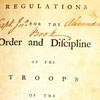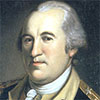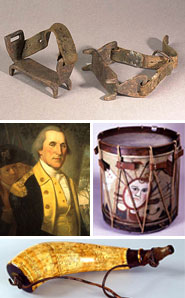|
- Verena Calas, National Park Service Museum Educator, Washington D.C
- 6-8 grades
- 5
[Back to top]
|
- This lesson unit plan draws on the extraordinary Valley Forge National Historic Park museum collections featured in the virtual museum exhibit at www.nps.gov/museum.
- Students will explore the challenges experienced by the Continental Army and its leadership, including General Washington, during their encampment at Valley Forge during the winter of 1777-1778 through object-based learning, hands-on activities, and active research. Students will work with and analyze primary source materials; including original Washington correspondence and other related documentation. Students will have the opportunity to make connections between the Revolutionary War period and the present by examining the similarities and differences between the original training manual of General Von Steuben and modern military manuals. Students will also practice analytical research, close reading, and debate skills through the examination of symbolism in colonial currency, the analysis of 18th century portraiture, and the discussion of women's role in the military.
- : During the American Revolution, General Washington and the fledgling Continental Army encountered many obstacles. However, from the Valley Forge encampment they emerge an organized and trained fighting force. Therefore, what obstacles did soldiers encounter while at Valley Forge? And, what factors contributed its emergence as a trained professional fighting force?
The following lesson plans are organized individually but make up a cohesive unit plan for "The Winter at Valley Forge". Teachers can choose to teach all five lessons as a unit, or each individually.
- This lesson introduces students to the challenges experienced by every day soldiers and their commanding officers during the winter at Valley Forge and explores how they dealt with these challenges not only physically, but mentally, as well.
- This lesson introduces students to the primary source documentation and analysis through the correspondence of men living in the Valley Forge encampment. Students will get another look into the challenges the camp presents as well as the emotional toll war can on the soldiers fighting it.
- This lesson explores the military training and tactics introduced by General Von Steuben at Valley Forge. Students will explore the importance of military manuals as modes of sharing information amongst large organized groups.
- This lesson explores the various rolls of women at the Valley Forge encampment. Students will compare the experiences of Valley Forge women to the changing rolls of American women in the military throughout history and partake in a class debate.
- This lesson explores the different kinds of currency and symbolism used not only in the Valley Forge Camp, but in the Thirteen Colonies at large. Students will also engage in the mathematical exchange of money.
[Back to top]
|
| This lesson introduces students to the challenges experienced by every day soldiers and their commanding officers during the winter at Valley Forge and explores how they dealt with these challenges not only physically, but mentally, as well. |
| MUSEUM OBJECT [photos of objects in the Parks museum collections] |
SIMILAR OBJECTS [local items similar to museum objects] & OTHER MATERIALS |
Length of time |
|
Activity 1: Warm Up – Who is Von Steuben?
|
20 minutes |
|
|
 |
 |
Regulations For The Order and Discipline of the Troops
|
Baron Von Steuben |
|
|
|
|
|
30
minutes |
|
Activity 1: Warm Up – Who is Von Steuben?
|
55 minutes |
[Back to top]
|
Describe how a text presents information (e.g., sequentially, comparatively, causally).
Integrate visual information (e.g., in charts, graphs, photographs, videos, or maps) with other information in print and digital texts.
Analyze the relationship between a primary and secondary source on the same topic..
[Back to top] |
- SWBAT compare and contrast primary and secondary source documents to analyze the similarities and differences between Revolutionary Era and current military tactics and training.
- SWBAT analyze the effects of Von Steuben’s training tactics on the Continental Army and its future military successes in the Revolutionary War.
- SWBAT translate and transcribe primary source documents.
[Back to top]
|
Von Steuben Makes and Army PowerPoint
[Back to top]
|
Drills: instruction or training in military exercises.
Manual: a book of instructions; a handbook.
Regulation for the Order and Discipline of the Troops of the United States: military manual written by General Von Steuben to aid in the training of the Continental Army, and later United States Army. It remained the instructional book of the army until 1812. |
|
-
Adapt “Create Your Own Procedural Manual” project scenarios to fit specific curriculum/student needs or allow students to develop their own.
- Bring other kinds of manuals (appliances, electronics, sports) to class for students to use comparatively.
[Back to top] |
[Back to top]
|
|
Other Materials Listed in Sections C
|
- Visit the Valley Forge National Historic Park Virtual Exhibition
- Visit the Valley Forge National Historic Park Website
|



